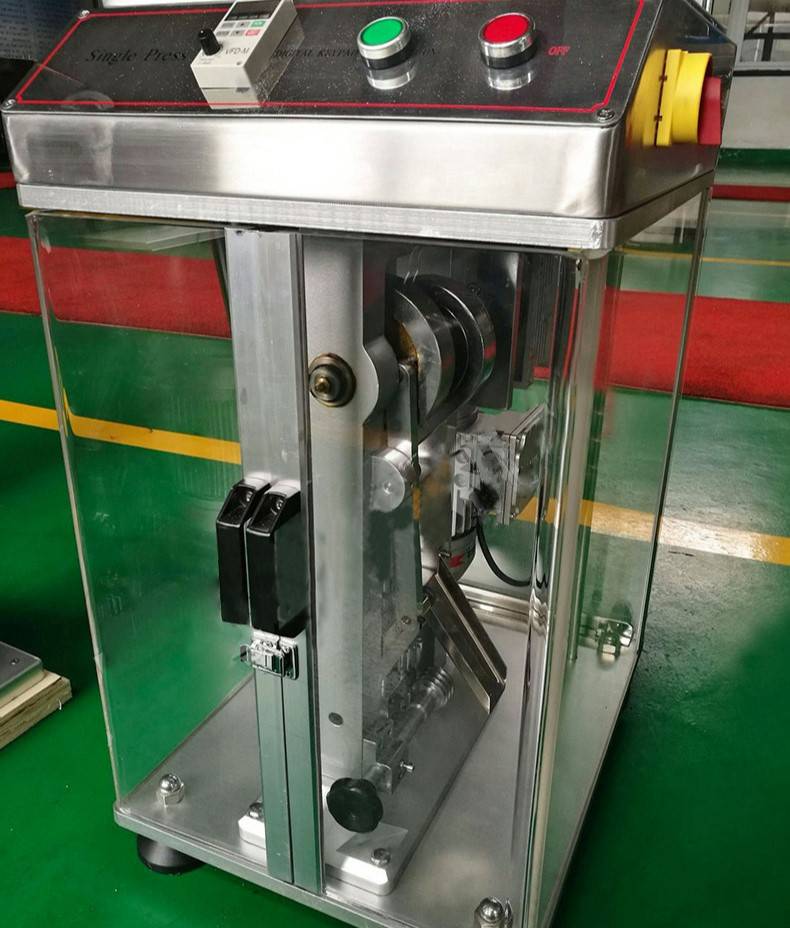
Tablet punching machine
Single Punch Electric Tablet Press Machine Laboratory Powder Tablet Punching TDP Tablet Press
Item Number : TPM-03
Price varies based on specs and customizations
- Adjustable punching pressure
- 50KN
- Adjustable tablet diameter
- 5mm - 25mm
- Adjustable tablet thickness
- 0.5-8mm
- Motor power
- 1.5kW
Shipping:
Contact us to get shipping details Enjoy On-time Dispatch Guarantee.
Why Choose Us
Reliable PartnerEasy ordering process, quality products, and dedicated support for your business success.
Introduce
The single-punch electric tablet press is a laboratory-scale tablet press suitable for corporate laboratories in pharmaceutical, chemical, food, metallurgical and other industries.
The single-punch electric tablet press can press various powdery granular raw materials into discs or special-shaped tablets. It is mainly used for experimental products such as hospital preparation rooms, scientific research institutions, factory laboratories, and factory laboratories.
The single-shot electric tablet punching machine consumes less raw materials, has beautiful appearance and small size. It is also a model suitable for small-scale production by small pharmaceutical, chemical, food, metallurgical and other enterprises.



Technical specifications
| Adjustable punching pressure | 50KN |
| Adjustable tablet diameter | 5mm - 25mm |
| Adjustable tablet thickness | 0.5-8mm |
| Filling depth | 20mm |
| Production capacity | 3600 pieces/hour |
| Motor power | 1.5kW |
| Wooden box packaging Dimensions | 580*500*830mm |
| Weight including outer wooden box | 150kg (including export fumigation-free wooden box packaging) |
FAQ
What Is A Lab Press?
How Do Electric Laboratory Presses Work?
What Is The Purpose Of A Hydraulic Press In Lab?
What Are The Advantages Of Using Electric Laboratory Presses?
What Are Different Type Of Lab Presses?
What Are The Applications Of Electric Laboratory Presses?
What Considerations Should Be Taken When Selecting An Electric Laboratory Press?
4.7
out of
5
Kintek Solution's Tablet Press Machine R&D Lab Model is a must-have for any laboratory. It's efficient, precise, and easy to use. Our team has been using it for months now and we've had no problems. Highly recommended!
4.9
out of
5
We purchased the Tablet Press Machine R&D Model for our pharmaceutical laboratory and it has exceeded our expectations. The machine is well-built, durable, and produces high-quality tablets. We are very happy with this purchase.
4.8
out of
5
As a laboratory manager, I am always looking for ways to improve efficiency and accuracy. The Tablet Press Machine R&D Model from Kintek Solution has been a game-changer for us. It's fast, reliable, and produces consistent results. I highly recommend this machine to any laboratory.
4.7
out of
5
I am very impressed with the Tablet Press Machine R&D Model. It's a well-designed and well-built machine that produces high-quality tablets. I would definitely recommend this machine to anyone in the pharmaceutical industry.
4.9
out of
5
We have been using the Tablet Press Machine R&D Model for over a year now and we have been very happy with its performance. The machine is easy to use and maintain, and it produces high-quality tablets. I would definitely recommend this machine to any laboratory.
4.8
out of
5
The Tablet Press Machine R&D Model is a great value for the price. It's a durable and reliable machine that produces high-quality tablets. I would definitely recommend this machine to anyone in the pharmaceutical industry.
4.7
out of
5
I am very happy with the Tablet Press Machine R&D Model. It's a well-designed and well-built machine that produces high-quality tablets. I would definitely recommend this machine to anyone in the pharmaceutical industry.
4.9
out of
5
We have been using the Tablet Press Machine R&D Model for over a year now and we have been very happy with its performance. The machine is easy to use and maintain, and it produces high-quality tablets. I would definitely recommend this machine to any laboratory.
REQUEST A QUOTE
Our professional team will reply to you within one business day. Please feel free to contact us!
Related Products

Single Punch Electric Tablet Press Machine TDP Tablet Punching Machine
The electric tablet punching machine is a laboratory equipment designed for pressing various granular and powdery raw materials into discs and other geometric shapes. It is commonly used in pharmaceutical, healthcare products, food, and other industries for small batch production and processing. The machine is compact, lightweight, and easy to operate, making it suitable for use in clinics, schools, laboratories, and research units.

Single Punch Manual Tablet Press Machine TDP Tablet Punching Machine
Single punch manual tablet punching machine can press various granular, crystal or powdery raw materials with good fluidity into disc-shaped, cylindrical, spherical, convex, concave and other various geometric shapes (such as square, triangle, ellipse, capsule shape, etc.), and can also press products with text and patterns.

Lab Scale Rotary Single Punch Tablet Press Machine TDP Tablet Punching Machine
This machine is a single-pressure automatic rotating, continuous tableting machine that compresses granular raw materials into various tablets. It is mainly used for tablet production in the pharmaceutical industry, and is also suitable for chemical, food, electronics and other industrial sectors.

Single Punch Tablet Press Machine and Mass Production Rotary Tablet Punching Machine for TDP
Rotary tablet punching machine is an automatic rotating and continuous tableting machine. It is mainly used for tablet manufacturing in the pharmaceutical industry, and is also suitable for industrial sectors such as food, chemicals, batteries, electronics, ceramics, etc. to compress granular raw materials into tablets.

Stainless Steel Laboratory Ball Mill for Dry Powder and Liquid with Ceramic Polyurethane Lining
Discover the versatile stainless steel dry powder/liquid horizontal ball mill with ceramic/polyurethane lining. Ideal for ceramic, chemical, metallurgical, and building materials industries. High grinding efficiency and uniform particle size.
Related Articles

Innovative tableting solutions: a comprehensive analysis of laboratory single punch tablet presses
Discover the working principle of lab single punch tablet press and its advantages. Learn how it operates and its role in research and development. Find out the differences between single punch and rotary tablet presses.

Sample preparation and unloading method of electric tablet press
How to prepare and unloading the sample? When tablet pressing, the operator must set the parameters of pressure, speed, and time according to the process requirements, so that the formed tablets meet the requirements for strength, hardness, and weight.

The working process of the tablet press you should know
What is tablet press and the working process of tablet press.

In-depth Analysis of Tablet Press Machine R&D Lab Model (1)
The Tablet Press Machine R&D Model, also known as a single punch tablet press, is designed for the development and small batch production of tablets. It is widely used in industries such as pharmacy, chemical, food, and metallurgy. This machine operates automatically, continuously filling, pressing, and ejecting tablets. Its key features include high precision filling, low noise, low material consumption, and smooth operation. It is particularly useful for research and development in laboratories, hospitals, and plants, catering to small-scale production needs.

Fully automatic tablet press operating steps and replacement accessories
Relevant introduction to the operating steps and replacement accessories of the fully automatic tablet press

Operating steps and precautions for electric tablet press
Relevant introduction to the operating steps and precautions of electric tablet press.

Lab Scale Mini Tablet Press: Applications, Processes, and Features
Laboratory scale small tablet presses are versatile and essential tools for the pharmaceutical and related industries. It plays a vital role in producing simple yet precise tablets from powders, making it an integral part of research and development.

Understanding the Tablet Press Machine R&D Lab Model and its Features(2)
The Tablet Press Machine R&D Model, also known as a single punch tablet press, is designed for the development and small batch production of tablets. It is widely used in industries such as pharmacy, chemical, food, and metallurgy. This machine operates automatically, continuously filling, pressing, and ejecting tablets. Its key features include high precision filling, low noise, low material consumption, and smooth operation. It is particularly useful for research and development in laboratories, hospitals, and plants, catering to small-scale production needs.

Classification of tablet press molds and precautions for use
During the stamping process.A stamping die is a tablet press die that compresses a sample or tablet during the stamping process. The stamping die is placed on top of the tablet press and the sample is placed on top of the die. The die is then compression molded to the desired shape and size. here are some classification of tablet press molds and precautions for use.

Operating steps and precautions for electric isostatic press
Relevant introduction to the operating steps and precautions of the electric isostatic press.

Detailed Analysis of Tablet Presses: Their Types, Components, and Applications
Tablet presses are machines designed to compress pharmaceutical powders and granules into tablets. They play a crucial role in the pharmaceutical industry by ensuring the uniformity of each dosage unit, which is essential for patient safety. The precision capabilities offered by modern tablet presses are invaluable for pharmaceutical companies, as they help create tablets that contain the same amount of active pharmaceutical ingredients and excipients.

Manual tablet press operating steps and precautions
Details on the operation of manual tablet presses, replacement of rubber rings, and steps for replacement of parts.